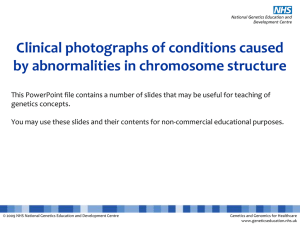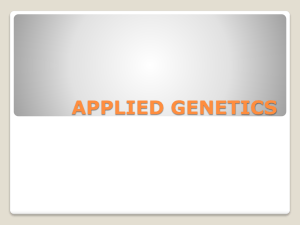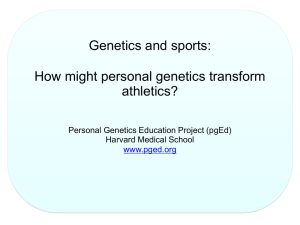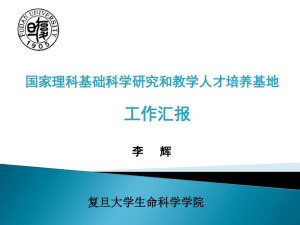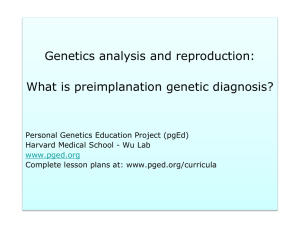Service Delivery - Model for the Future
advertisement
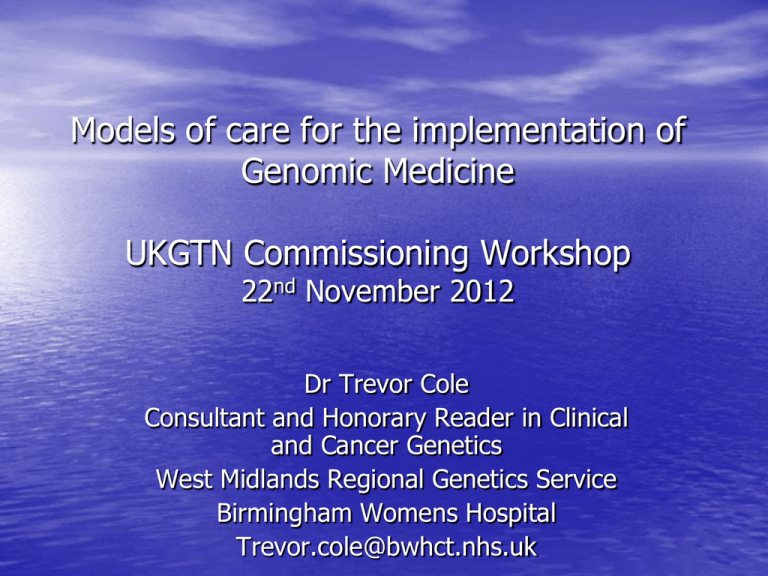
Models of care for the implementation of Genomic Medicine UKGTN Commissioning Workshop 22nd November 2012 Dr Trevor Cole Consultant and Honorary Reader in Clinical and Cancer Genetics West Midlands Regional Genetics Service Birmingham Womens Hospital Trevor.cole@bwhct.nhs.uk NHS ill- prepared Sub-committees to identify educational needs www.geneticseducation.nhs.uk Equitable delivery of high quality integrated pathways Molecular test Patient management Family management Management could mean :• Diagnosis • Patient Treatment (personalised medicine) • Pre-symptomatic testing • Surveillance Maximise to obtain most clinical benefit and utility Molecular test Patient management Family management What are we trying to achieve? Patient Access Diagnostic Process Personalised Medicine What are we trying to achieve? Optimisation of each of the Steps Patient access • Equal access Diagnostic process • Who • How • Consent Personalised medicine • Education of NHS • Engagement with pharma and biotech What are we trying to achieve? Optimisation of each of the Steps and Extended family engagement where appropriate Patient access • Equal access Diagnostic process • How • Who • Consent Personalised medicine • Education of NHS • Engagement with pharma and biotech Access: success and failure Retinoblastoma Breast and Colon cancer Common Disorders: Hypercholesterolaemia, Diabetes, Chronic Renal failure Highly successful Quite successful Much less successful Informed expert driven Patient driven and medical reactive Why? Less aware public and professions Access success – simple!! (If only) • Educated and engaged public • More aware profession and easier access to pathways (know when to refer) • Commissioning process that encourages early intervention for the “well” – primary and secondary care Illustration of Diagnostic Process Deliberations and Consequences :- Is it? • Marfan syndrome • Rare aortopathy • Homocysteinuria Making the Diagnosis of Marfan Syndrome Clinical Molecular For Against For Against Its cheap Not made a definite diagnosis Precise diagnosis Additional upfront expense In comfort zone Still some benefit even if wrong aortopathy I just saved £500! Not recognised correct aortopathy Life long follow up at risk Identify at risk relatives, or exclude. Personalised medicine If wrong gene money down the drain! No relatives in my area Worried about consent and sharing confidential information How to encourage most appropriate diagnostic process :– make it part of a required pathway • Homocysteinuria – urine adequate only if no other management issues • Marfans – is a clinical diagnosis adequate to answer “all the other medical issues” to the benefit of “the whole NHS” • Rare aortopathy – do I need to be aware of these alternative diagnoses and management issues Use SCN and NHSCB through CRG to :• Promote commissioning of MDT working • Optimise pathway • Support most appropriate clinical involvement (eg Marfans – expert cardiology, cardiothoracic surgeons, ophthalmology, clinical geneticists, nurse specialist/ genetic counsellors, orthopaedics, physiotherapy etc) What are we trying to achieve? Optimisation of each of the Steps and Extended family engagement where appropriate Patient access • Equal access Diagnostic process • How • Who • Consent Personalised medicine • Education of NHS • Data collection • Engagement with pharma and biotech For “each patient” MDT discussion or agreed protocols to consider appropriate :- • Diagnosis (What do I need to achieve 2 &3) • Management • Genetic Cascade • “premium for care” in “quality assured pathways” to cover initial expenses but to ensure downstream benefits (central to UKGTN gene dossiers – link from NLMC) Engagement of Public and Professionals (Requirement of the quality assured pathway) • HGSG – importance of engagement and • • • • • education GMC – medical school requirement Royal Colleges and NMC – JCMG report HEE – ensure part of the “CPD curriculum” for LETB’s – remove the “unknown unknowns” Member of NCB with remit to genomics and promotion of education across the NHS Commissioners only support “QAP” Encourage engagement of Pharma and Biotechnology • Smaller number of collaborators for more patients enrolled • More consistent cohorts • More consistent evaluations • More cost effective research More consistency of consent • More consistency of consent process • Increased awareness of equivocal results and • • interpretation Greater support for interpretation of equivocal results Greater emphasis on sharing information for knowledge and family management as norm rather than exception or retrospective Should not be “a charter for ivory towers” practice : Criteria should be QAP delivery • Rare is common – 3 million people in England have a rare disorder. • 80% genetic • Many multisystem But many • Common enough to be managed in many centres (1 versus >1 per “sector”) • Need a lot of local support and input – horizontal integrated care with IT systems to share relevant data and protocol management Inherited cardiac disease Led by clinical genetics Cancer genetics Led by clinical genetics with pathways integrated into primary and secondary care Neurogenetics Provided from within neurology Endocrine genetics Service Led by endocrinology with integrated clinical genetics Familial hypercholesterolaemia Structured multidisciplinary pathway led by lipid clinic clinicians with family cascade service hosted by regional genetics service Single gene diabetes Led by diabetology with network of specialist nurses Extended family engagement where appropriate Patient access • Equal access Diagnostic process • How • Who • Consent Personalised medicine • Education of NHS • Engagement with pharma and biotech Inherited cardiac disease Led by clinical genetics Cancer genetics Led by clinical genetics with pathways integrated into primary and secondary care Neurogenetics Provided from within neurology Endocrine Genetics Service Led by endocrinology with integrated clinical genetics Familial Hypercholesterolaemia Structured multidisciplinary pathway led by lipid clinic clinicians with family cascade service hosted by regional genetics service Single gene diabetes Led by diabetology with network of specialist nurses Non Geneitc Genetic Alcohol Drugs Viral HOCM, Fabry Disease DMD Haemochromatosis Smoking Obesity Cholesterol Diabetes Hypertension Cardiomyopathy Drugs Metabolic Conduction disorder Unexplained cardiac collapse LQT / Channelopathies Metabolic Myotonic Dystrophy Myocardial infarct Obesity (Leptin) Cholesterol (FH) Diabetes (MODY) Hypertension (GRBP) Aortopathy Age Hypertension Smoking Marfans Ehlers Danlos Non Syndromic familial aortopathies Geleophysic – Acromicric Dysplasia Need to overcome - “Who pays for the test?” • Geleophysic – AR due to mutations in ADAMTLS2 gene • Geleophysic/Acromicric – AD due to mutations in the fibrillin gene • Prognosis differs across spectrum • Fibrillin mutation disorders show evidence of response to anti TGF therapy • Recurrence risk 1 in 2, 1 in 4 or very low Multiple Endocrine Neoplasia type 2 (MEN 2) • MEN 2A MTC Phaeochromocytoma Hyperparathyroidism • MEN 2B MTC Phaeochromocytoma Marfanoid habitus Mucosal neuroma Ganglioneuromatosis gut • Familial MTC ≥4 MTC No phaeochromocytoma No hyperparathyroidism Joint MTC at QEH 19 apparently sporadic MTC presenting to QEH over 2 years A mutation was identified in 3/19 (15.8%) V804M heterozygous V804M homozygous C618S heterozygous Subsequent cascade testing in at risk family 43y male 54y female 30y female members • → 18 predictive genetic tests → 13 positive → 11 prophylactic thyroidectomies Joint MTC at QEH Histology at prophylactic surgery Non neoplastic CCH 1 Borderline CCH 1 CCH 3 MTC 5 Await histology 1 • MTC identified in 5 /11 (~45.5%) at prophylactic surgery C618S family 53y 40y 36y 29y female female female female V804M families 65y female Indications for using DNA testing :genetic management • • • • • Cascade screening Prevention of unnecessary intervention Appropriate surveillance for at risk individuals Is presymptomatic diagnosis and intervention going to change the outcome? Does knowing the genetic basis change the management – (Germline) Warfarin dosage, PARP inhibitors, PTC124. (Somatic - oncology) Herceptin, Gleevac and Iressa Common Disease with a Major Genetic Component • • • • • • Renal Failure Heart Disease Hypertension Osteoporosis Diabetes Melitus Most Types of Cancer • All can be single gene or • • • • • multifactorial All amenable to intervention Surveillance is often very simple Genetic testing maybe difficult and expensive Taking a family history is very easy and cheap! Some genetic testing is very beneficial Indications for genetic testing or (How to persuade your commissioners!) • Diagnosis (avoidance of unnecessary investigations) • Management (most appropriate follow up and treatment) • Genetic follow up (identification of gene carriers and exclusion of population risk follow up) • Ensure you get the maximum clinical utility from you test (a no brainer???)
